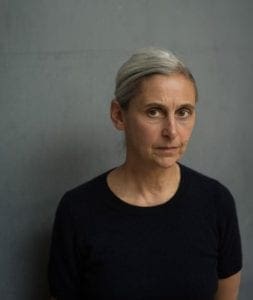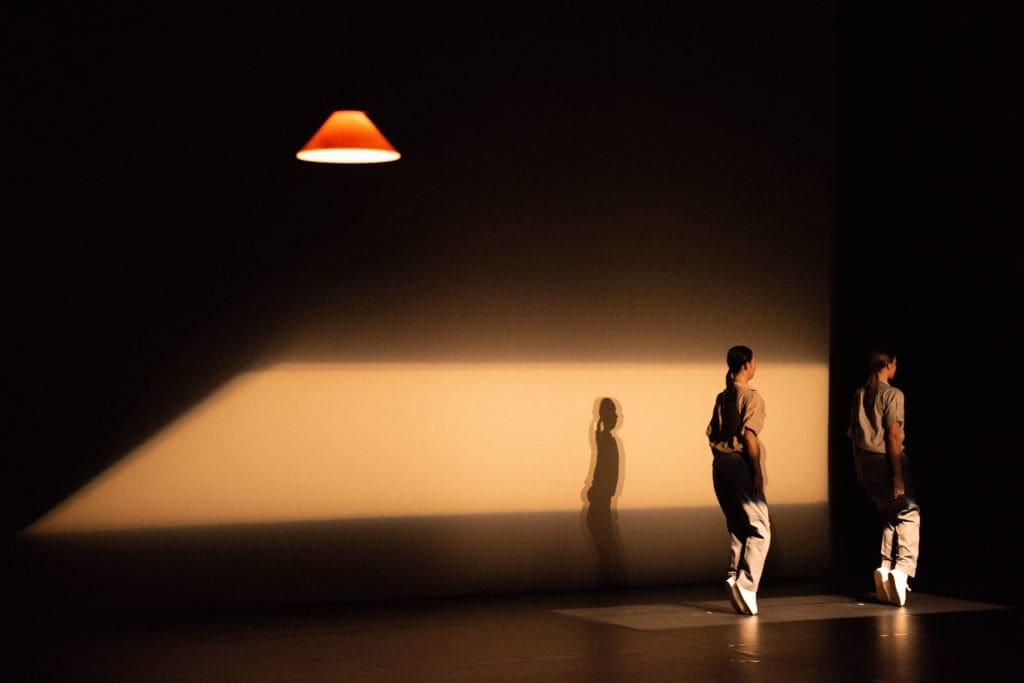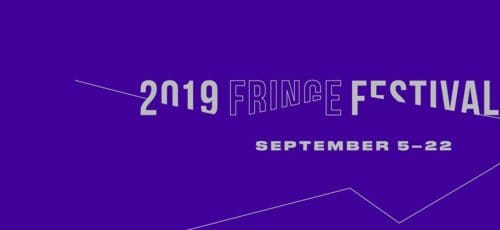‘The Greatest Step of Them All’: Anne Teresa De Keersmaeker Passes On her Fase to the Next Generation
Anne Teresa De Keersmaeker’s breakthrough came in 1982, at the age of twenty-one, with Fase, Four Movements to the Music of Steve Reich. For years, she continued to dance the piece herself. In 2018, however, the moment came for her to pass the torch to a new generation of Rosas dancers, who will perform it in Philadelphia September 12–14 as part of the 2019 Fringe Festival. Anne Teresa spoke to Rosas archivist and dramaturg Floor Keersmaekers about the relationship between the past and present of Fase, and the road traveled between both versions.
Floor Keersmaekers: Together with Rosas danst Rosas, Fase is the performance that has been on stage the most of all pieces, and has remained on the program all this time. Now, the time to pass on the choreography to a new generation of dancers seems to have come. Would you mind explaining why Fase is so important to you and to Rosas?
 Anne Teresa De Keersmaeker: Strictly speaking, Fase is not my first choreography – before that there was Ash (1980) – but it really was a seminal work, showing the first traces of a composition style I was later to make my own. Ash still was an exploration, an attempt to spy out the land. Fase is about the art of choreography, the art of composing movements that I wanted to master so badly as an autodidact. Violin Phase was the starting point for that exercise. When I left for New York to study at the Tisch School of the Arts in 1980, I kept a recording of Steve Reich in my travel sack. During the first months of my studies, I was bent on creating my own dance. I continued to consider this solo as ‘my’ own piece of dance, mainly since it contained all the elements that defined the (now 36-year) road that tracked the tight relationship between dance and music, and the concept of choreography as the art of organizing movements in time and space, where the music determines the time format and the space is divided based on an underlying geometry.
Anne Teresa De Keersmaeker: Strictly speaking, Fase is not my first choreography – before that there was Ash (1980) – but it really was a seminal work, showing the first traces of a composition style I was later to make my own. Ash still was an exploration, an attempt to spy out the land. Fase is about the art of choreography, the art of composing movements that I wanted to master so badly as an autodidact. Violin Phase was the starting point for that exercise. When I left for New York to study at the Tisch School of the Arts in 1980, I kept a recording of Steve Reich in my travel sack. During the first months of my studies, I was bent on creating my own dance. I continued to consider this solo as ‘my’ own piece of dance, mainly since it contained all the elements that defined the (now 36-year) road that tracked the tight relationship between dance and music, and the concept of choreography as the art of organizing movements in time and space, where the music determines the time format and the space is divided based on an underlying geometry.
Finally, it also speaks to a strongly ‘focal’ use of energy. The vocabulary of movements deployed is highly minimalistic, almost mundane. Turning, jumping, swinging arms… it somewhat resembles the way a child dances. Yet in opposition to the simplicity of movements stands the outspoken energy of its execution. It is that tension I explored further in Rosas danst Rosas. The investment of such a high amount of physical energy in a composition culminates in a discharge that shares a great deal of emotional tension. At the time, that was at odds with the main strands of American minimalistic dance, which were based on a detached, almost mathematical sense of calculation and precision that required little to no personal involvement on the behalf of the dancer. Conversely, and in spite of the very tight structure and formality, dancing Fase has a great physical and—thus also emotional—intensity to it.
FK: With respect to Rosas danst Rosas, you’ve repeatedly claimed that the repetitive and highly structured character of the choreography in question requires a great deal of individual charisma and personality on behalf of the dancer. This seems due to the fact that, despite the choreography’s great uniformity, that’s what renders their performance different. Fase is even more formal and abstract; would it be correct to say that, in this instance, the casting is at least as important as the dancing in order for a successful transfer to take place?
ATDK: In fact, the piece in question was developed in three stages. In the first, I created Violin Phase, my own solo, in which, naturally, the casting is of great importance. After all, I was working with my own body, writing a choreography by dancing myself, all whilst dancing in the act of creating my own choreography. This double starting point is part of the dance’s DNA, and strongly intertwined with my mode of movement. Come Out was the next part which I created with Jennifer Everhard. In that case, it was important to have two women, just like in the two subsequent parts, Piano Phase and Clapping Music, which I later wrote with Michèle Anne De Mey.
In a way, the movements have become ‘grafted’ onto my body, which at the time was the body of a young woman. In order to come up with a choreographic answer to the repetitive minimal music by Reich, I sought to stretch its visual conformity as much as possible to most adequately demonstrate what was different and what was the similar in the performance. Take Piano Phase, for instance: that dance would have ended up completely different if one were to put a man and a woman next to each other. Perhaps nowadays, at a time when the notion of gender liquidity has become more widespread, it may be old-fashioned to hold on to the fact of the female body with such tenacity, a basic assumption that can (rightfully) be questioned. Yet I do find this physical similarity of two women important. I even take into account the height of dancers and their hairstyles.
 FK: You combine the rehearsals to revisit Fase with the rehearsals for a wholly new production. A period of more than thirty years bridges the gap between the two creations. Do you try to keep both activities in strict separation, or is there an interaction between the two that you tend to tolerate, and perhaps even encourage?
FK: You combine the rehearsals to revisit Fase with the rehearsals for a wholly new production. A period of more than thirty years bridges the gap between the two creations. Do you try to keep both activities in strict separation, or is there an interaction between the two that you tend to tolerate, and perhaps even encourage?
ATDK: The situation definitely creates perspective, and invites reflection. One looks back on those decisive decisions and how one came to make them. At times it is easy to forget how they came about; occasionally, they resurface when re-examining previous performances. That is the process by which ideas are refreshed, after al. I do question myself about the importance of the composition in and of itself, which is a separate question from the dancers who interpret it, whether it’s at the moment of creation itself or the reprisal. I have always said that performances become what they become due to the fact that dancers play such a capital role in the creative process. Still, a situation like this does create an urge for reflection on how a composition can remain intact and be passed on.
FK: Do you feel that with the passing of time the retaking of a repertoire gets easier, or do you experience it like wholly new process every time?
ATDK: We now have a core group of dancers who have performed five different pieces in the repertoire: Rain, A Love Supreme, Rosas danst Rosas, Zeitigung and Achterland. Fase is the sixth project. I myself do notice that these dancers have an accumulated history with the work, that they have quite literally incorporated my ‘language’, and that this language gains depth every time it’s taken up again. One begins to share a common ground with those dancers and that is immensely important. But Fase does confront a dancer with specific challenges inherent to the piece itself. The choreography verges on the extreme with its combination of great physical intensity and strict formality, together with the requirement for it literally to be given a divine ‘breath of life’. This is an element that is prone to disintegration, or to a temptation of mechanicality. The right amount of energy should be invested in this piece.
FK: Your choice of music is very diverse, but it also betrays a specific strand of preferences. The work by Steve Reich makes up a large part of it, and of course there is Bach as well. Are there similarities in the way their compositions appeal to you or do you see, from your experience as a choreographer, commonalities in their music?
ATDK: Although I believe the differences are plenty, their work does exert some strong commonalities. First and foremost, both composers made highly structured music, although Bach is slightly less systematic than Reich. Then there is the presence of a ‘pulse’, meaning there is always an ‘invitation’ to dance. But what seems crucial to me is that the repetitive part in Reich’s music closely resembles something called canon writing. Bach is known as master of the canon and especially as master of the fugue, a music form based on the canon. In fact, the key to fugue is the maximal exploitation of a minimum of material. I believe that is an important principle that the music of Bach and Reich share and from which I, as a choreographer, draw a lot of inspiration.
As an autodidact, my choice to start with Steve Reich may have had something to do with my own sense of insecurity. I literally wanted to take on this piece on a step-by-step, digging through its substance layer by layer. Reich’s minimalistic music was very well suited to that, mainly because of its flexible yet simplistic structure. When I was making Violin Phase I tended to play Bach’s Brandenburg concertos in the studio. That piece of course invites dancing, but at that time I simply wasn’t yet ready to face that complexity. For that, I first needed to acquire more experience.
FK: In Fase you took on the roles of both dancer and choreographer. Is that something you would recommend to other dancers? In other words, do you believe that choreographic practice makes one a better dancer?
ATDK: No, I do not believe it does. They are two different things, really. While training as a dancer, I tended to start with choreography since I wanted to develop my own style, but that desire had nothing to do with the fact that I also liked to dance. I wanted to come up with my own vocabulary of movements, with its own grammar, rather than embed myself in an existing dance language.
Also, the line dividing choreography and dance has become rather blurry over the last 30–40 years. Today, dancers are typically much more involved in the creative process than they were before, and the two tend to blend into each quite a bit. Nevertheless, the development of a choreographic style does require a variegated approach. It involves shaping movement in time and space and that requires a certain vision. Call it craftsmanship: ‘how do we go about doing this’? And, in the end, social skills are also paramount, precisely because one is working with dancers as ‘people’.
FK: Looking back on your track record, only one other solo (Once) appears alongside Violin Phase, conceived in 2002. Does that imply the development of a different outlook on the relationship between yourself as a choreographer and as a dancer?
ATDK: No, not really. In fact, after Once I did dance other solos, in Keeping Still and in 3Abschied. It is far from easy to find the time for it in addition to the other work and all other responsibilities. When I was 21 and still studying, my working circumstances were different from how they are now. Beyond that, it has been a very special and valuable experience to continue dancing the same dance over a period of more than 35 years.
FK: Did the wear and tear of time and experience have any influence on your way of dancing Fase? Would you say the piece has undergone a ‘change’, that its substance is no longer the same as that of the première in 1982?
ATDK: As a choreographer, one tends distinguish the composition from the ‘embodiment’ of that composition itself. I have to say that the current transition—or, the fact that I suddenly find myself standing ‘outside’ the existing choreography and looking at it from a fresh perspective—is a bigger step than any other in the past 36 years. My relationship with Fase has never ceased to evolve; never did there occur a gap or a pause. In quite a literal sense, the piece remained a piece of body. It may well be that the movement has changed en cours de route. In that case, I’m not talking so much about the composition, which remains fixed and set in place. It is the embodiment of that composition that has evolved with me. But now I do feel the time has come for a new chapter.
What: Fase, Four Movements to the Music of Steve Reich
When: September 12–14, 2019
Where: FringeArts, 140 North Columbus Boulevard
Cost: $15–$39
Created by Anne Teresa de Keersmaeker / Rosas
https://fringearts.com/event/fase-four-movements-to-the-music-of-steve-reich/
Photos by Hugo Glendinning (portrait of De Keersmaeker), Anne Van Aerschot (featured, middle, and below)



